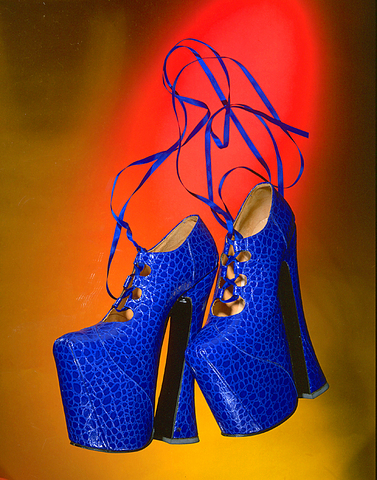If you're familiar with the 1970s punk band the Sex Pistols, then you also know the punk fashion look of bondage, latex, and safety pins. These outfits were created by London fashion designer Vivienne Westwood and she is currently in Taipei for the opening of her 30-year retrospective at the Taipei Fine Arts Museum, which opens today to the public and runs to Oct. 19. Last night was the gala preview party with a special performance by local artist Mr Eyeball.
The Vivienne Westwood exhibition features her provocative fashion designs over the last 30 years. Organized by the Victoria and Albert Museum in London, the exhibition provides a chronological view of her work divided into two sections.
"The Early Years" starts with the subversive punk outfits from the 1970s that led to the pirate-inspired gear of the 1980s. "Maturity" features the later work of bustles and bustiers, from the 1990s up to the present, including beautifully-crafted suits, flamboyant knits and ball gowns.

Over 500 designs are on view. In addition to the fashion, there is a series of British cultural activities organized by the British Council to show the link between pop culture, design, music and how the influence of politics and social issues comes into play.
Westwood is a big-time designer and her influence has reached Taiwan where many of the local designers have studied her work. So this exhibition has been highly anticipated in the local fashion world.
In the early 1970s, Westwood who was born in 1941, opened up a trendy clothing shop called "Let it Rock" with her partner Malcolm McLaren who was the Sex Pistol's manager. Westwood's designs included leather jackets, bondage clothing with straps and buckles, and printed T-shirts. They all became part of the punk frenzy.
By the 1980s, however, fashion had changed drastically and Westwood, who was inspired by history and culture, changed her design style in many ways too.
One of the underlying themes in her work over the past 30 years is appropriating bits and pieces of British history to include into her designs, such as flouncy crinoline skirts, whale-boned corsets, tartan plaids and elements from ornately-designed Rococo paintings.
One thing the exhibition will show is that Westwood is not a stagnant designer repeating the tried and true, but that she remains a true iconoclast: inventing and reinventing new fashions while keeping her finger on the pulse of the moment.
Her fascination with 18th century French art is evident in many of her later designs, where the constructions distort and hide the body.
By seeing the Westwood retrospective, the viewer will get a crash course in art history and see how the influence of history and pop culture merge effortlessly in her work.
As Westwood said, "I'm not trying to do something different, I'm trying to do the same thing but in a different way."
Westwood is also a strong believer in how appearance plays a deep role in one's life. You'll be convinced too of the importance of fashion, upon seeing the exhibition.
For your information:
What: Vivienne Westwood Retrospective
Where: Taipei Fine Arts Museum,181, Zhongshan North Road, Section 3, Taipei (台北市中山北路3段181號)
Telephone: (02) 2595 7656
When: Today to Oct. 19

May 18 to May 24 Pastor Yang Hsu’s (楊煦) congregation was shocked upon seeing the land he chose to build his orphanage. It was surrounded by mountains on three sides, and the only way to access it was to cross a river by foot. The soil was poor due to runoff, and large rocks strewn across the plot prevented much from growing. In addition, there was no running water or electricity. But it was all Yang could afford. He and his Indigenous Atayal wife Lin Feng-ying (林鳳英) had already been caring for 24 orphans in their home, and they were in

On May 2, Chinese Nationalist Party (KMT) Chairman Eric Chu (朱立倫), at a meeting in support of Taipei city councilors at party headquarters, compared President William Lai (賴清德) to Hitler. Chu claimed that unlike any other democracy worldwide in history, no other leader was rooting out opposing parties like Lai and the Democratic Progressive Party (DPP). That his statements are wildly inaccurate was not the point. It was a rallying cry, not a history lesson. This was intentional to provoke the international diplomatic community into a response, which was promptly provided. Both the German and Israeli offices issued statements on Facebook

Even by the standards of Ukraine’s International Legion, which comprises volunteers from over 55 countries, Han has an unusual backstory. Born in Taichung, he grew up in Costa Rica — then one of Taiwan’s diplomatic allies — where a relative worked for the embassy. After attending an American international high school in San Jose, Costa Rica’s capital, Han — who prefers to use only his given name for OPSEC (operations security) reasons — moved to the US in his teens. He attended Penn State University before returning to Taiwan to work in the semiconductor industry in Kaohsiung, where he

Australia’s ABC last week published a piece on the recall campaign. The article emphasized the divisions in Taiwanese society and blamed the recall for worsening them. It quotes a supporter of the Taiwan People’s Party (TPP) as saying “I’m 43 years old, born and raised here, and I’ve never seen the country this divided in my entire life.” Apparently, as an adult, she slept through the post-election violence in 2000 and 2004 by the Chinese Nationalist Party (KMT), the veiled coup threats by the military when Chen Shui-bian (陳水扁) became president, the 2006 Red Shirt protests against him ginned up by